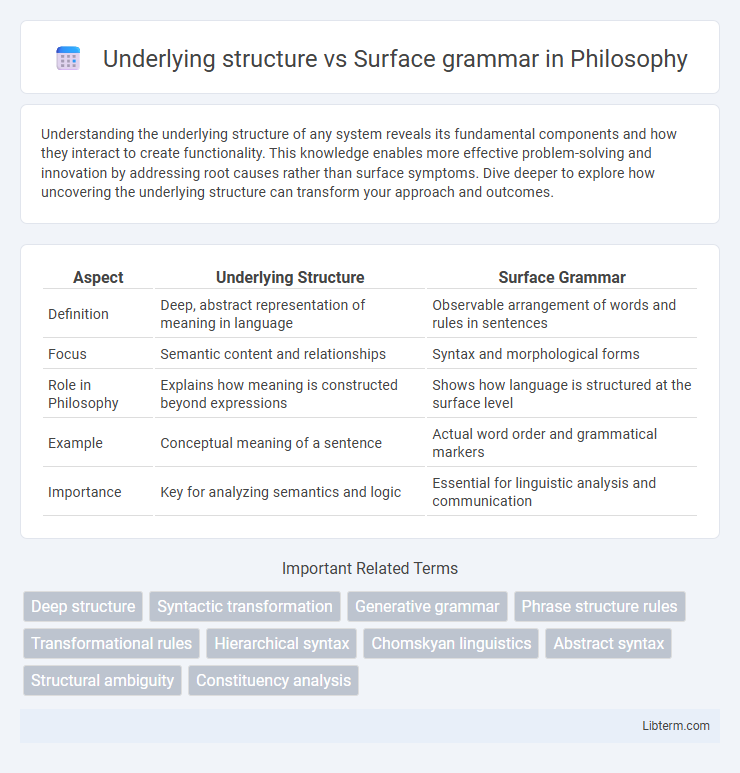Understanding the underlying structure of any system reveals its fundamental components and how they interact to create functionality. This knowledge enables more effective problem-solving and innovation by addressing root causes rather than surface symptoms. Dive deeper to explore how uncovering the underlying structure can transform your approach and outcomes.
Table of Comparison
| Aspect | Underlying Structure | Surface Grammar |
|---|---|---|
| Definition | Deep, abstract representation of meaning in language | Observable arrangement of words and rules in sentences |
| Focus | Semantic content and relationships | Syntax and morphological forms |
| Role in Philosophy | Explains how meaning is constructed beyond expressions | Shows how language is structured at the surface level |
| Example | Conceptual meaning of a sentence | Actual word order and grammatical markers |
| Importance | Key for analyzing semantics and logic | Essential for linguistic analysis and communication |
Introduction to Underlying Structure and Surface Grammar
Underlying structure represents the deep, abstract syntactic organization of a sentence, capturing its core meaning and relationships between elements before any transformations occur. Surface grammar refers to the actual spoken or written form of language, reflecting the final arrangement of words and phrases shaped by phonological, morphological, and syntactic rules. Understanding the distinction between underlying structure and surface grammar is fundamental for analyzing how meaning is encoded and how linguistic variations arise in different contexts.
Defining Underlying Structure in Language
Underlying structure in language refers to the deep, abstract representation of a sentence's meaning, capturing its essential syntactic relationships and semantic roles beyond the visible word order. It serves as the foundational framework from which surface grammar, the actual spoken or written form, is derived through transformational rules. Understanding underlying structures is crucial in linguistics for analyzing sentence formation, ambiguity resolution, and language acquisition processes.
What is Surface Grammar?
Surface grammar refers to the observable syntactic elements and word order in a sentence that follow the conventional rules of a language. It includes the arrangement of words, punctuation, and the explicit grammatical markers that shape how meaning is conveyed at a superficial level. Unlike underlying structure, which deals with the deep, abstract syntactic relations, surface grammar focuses on the actual, realized form of language used in communication.
The Relationship Between Deep and Surface Structures
The relationship between underlying structure and surface grammar centers on how deep structures represent the core semantic framework of a sentence, while surface grammar manifests these meanings through specific syntactic forms. Transformational grammar theories emphasize that deep structures contain abstract syntactic and semantic information, which undergo transformations to produce varied surface structures without altering meaning. Understanding this relationship enhances linguistic analysis by revealing how different sentence forms share a common underlying representation.
Examples Demonstrating Underlying Structure
Examples demonstrating underlying structure reveal how deep syntactic frameworks govern sentence formation beyond surface grammar variations. For instance, the sentences "She can sing" and "Can she sing?" share the same underlying structure expressing ability but differ in surface grammar due to word order changes for questions. Transformations like passive voice conversion, as in "The cat chased the mouse" versus "The mouse was chased by the cat," further illustrate the conserved underlying structure despite different surface expressions.
Surface Grammar Variations Across Languages
Surface grammar variations across languages manifest in diverse ways, including word order, verb conjugation, and case marking systems. These variations influence how languages encode syntactic relationships and convey meaning within sentences, despite sharing similar underlying structures. Understanding surface grammar differences is crucial for accurate linguistic analysis, translation, and natural language processing applications.
Syntactic Transformations: Connecting Deep and Surface Levels
Syntactic transformations operate as essential processes linking the underlying structure, or deep structure, of a sentence with its surface grammar, enabling the generation of varied grammatical sentences from a single deep representation. These transformations manipulate elements such as word order, phrase movement, and insertion or deletion to reflect different syntactic forms while preserving semantic content. Understanding the connection between deep and surface levels through syntactic transformations is crucial for parsing complex sentence constructions and modeling natural language syntax effectively.
Importance in Linguistic Analysis
Underlying structure reveals the deep grammatical relationships and semantic roles that govern sentence formation, providing essential insight into meaning beyond the surface level. Surface grammar represents the observable syntactic patterns and word order, which can vary across languages but sometimes obscure underlying linguistic rules. Understanding the distinction between underlying structure and surface grammar is crucial for accurate linguistic analysis, language acquisition studies, and the development of natural language processing models.
Underlying Structure vs Surface Grammar in Language Acquisition
Underlying structure in language acquisition refers to the deep, abstract representation of grammatical rules that learners internalize, enabling them to generate and comprehend sentences beyond mere imitation. Surface grammar consists of the observable syntactic forms and word orders used in speech and writing, which can vary widely yet stem from consistent underlying principles. Mastery of underlying structure allows learners to understand novel sentences and navigate linguistic variability, highlighting its crucial role over surface grammar in the cognitive process of acquiring language.
Implications for Language Teaching and Learning
Understanding the distinction between underlying structure and surface grammar enhances language teaching by emphasizing deep syntactic and semantic knowledge over rote memorization of surface forms. Focusing on underlying structures helps learners develop stronger grammatical intuition, improving their ability to generate and comprehend varied sentence constructions. Incorporating this approach fosters greater language acquisition efficiency and more flexible communicative competence.
Underlying structure Infographic

 libterm.com
libterm.com